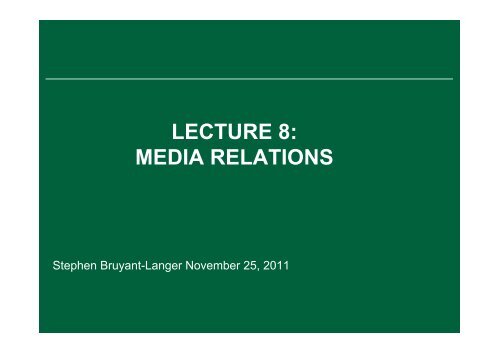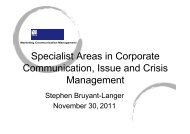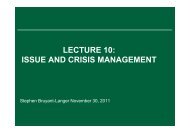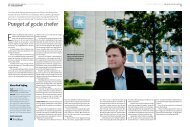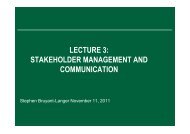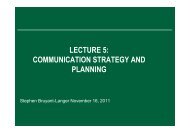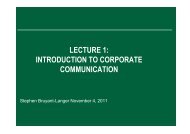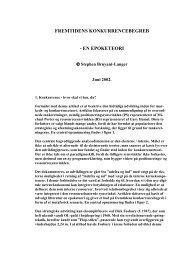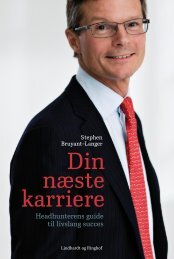LECTURE 8 MEDIA RELATIONS
Lecture 8 November 25, 2011
Lecture 8 November 25, 2011
- No tags were found...
Create successful ePaper yourself
Turn your PDF publications into a flip-book with our unique Google optimized e-Paper software.
<strong>LECTURE</strong> 8:<br />
<strong>MEDIA</strong> <strong>RELATIONS</strong><br />
Stephen Bruyant-Langer November 25, 2011
Lecture Structure<br />
• Media organizations<br />
• Impact of news coverage on corporate reputation<br />
• Agenda-setting theory<br />
• Framing news stories<br />
• Communication professionals<br />
• Tools and techniques in media relations
Media Organizations<br />
• News media - organizations with as core operational process the production and<br />
dissemination of news content through various media (newspapers, radio, TV and the<br />
internet).<br />
• The production of news content involves two levels: (1) journalists who consult sources<br />
and write news stories; and (2) other parties within the news organization (e.g., copy<br />
editors) who, based upon their news routines, edit stories before they make it into print.<br />
• News routines writing for a news desk (a national news desk, a local news desk, the<br />
financial/business news desk)<br />
• News routines may reflect certain ideology -- matters in terms of how organizations<br />
are covered in the news media and whether this will largely consist of ‘good’ or ‘bad’<br />
news coverage<br />
"<br />
• e.g., Guardian: middle-ground liberal to left-wing end of the political spectrum<br />
• recent BBC trust study found that programmes on the BBC (e.g., The Money<br />
Programme, Radio Five Live and the 10 O’Clock News) failed to represent<br />
shareholders’ and employees’ perspectives on corporate stories in favour of a<br />
consumer perspective. Criticized the BBC business editors’ negative and narrow<br />
views on business and made three recommendations: (1) the BBC should<br />
address the lack of knowledge of business issues among editorial staff; (2) widen<br />
‘the range of editorial ideas and programming about business’; and (3) ‘ensure<br />
compliance in business coverage with standards of impartiality’ (Conlan, 2007,<br />
‘BBC business news failing impartiality test, says report’, The Guardian, 26 May,<br />
p. 18).
Impact of News Coverage on Corporate Reputation<br />
• Media coverage often has an ‘amplifying’ effect on a company’s<br />
reputation when ‘good’ or ‘bad’ news is reported. It does not strictly<br />
determine a company’s reputation or the way in which stakeholders<br />
think about an organization, but it does have an impact in terms of<br />
highlighting an issue or increasing the already held positive or negative<br />
view of an organization.<br />
• Agenda-setting theory: hypothesis underlying the theory is that the<br />
frequency with which the media report on an issue determines that<br />
issue’s salience in the minds of the general public (McCombs and<br />
Shaw, 1972). In other words, ‘The press may not be successful much of<br />
the time in telling people what to think, but it is stunningly successful in<br />
telling its readers what to think about’ (Cohen, 1963, p.120).
Agenda-setting Theory<br />
Agenda-setting theory distinguishes two levels of agenda-setting.<br />
The first level of agenda setting relates to the salience of an<br />
organization, whereas the second level of agenda setting deals<br />
with the attributes or associations related to that organization.<br />
• Carroll (2004) content analyzed coverage of corporations in the New York<br />
Times. He then correlated the findings of news content with data on the<br />
public’s awareness of those corporations and their associations with those<br />
corporations. Positive results were found for both levels of agenda setting:<br />
results revealed that news coverage influences which corporations were<br />
salient in the public’s mind and the amount of media coverage devoted to<br />
certain corporate issues or attributes of the organization (e.g., workplace<br />
environment) were roughly in line with public associations regarding those<br />
corporations.<br />
• .
• Meijer (2006) confirmed the same agenda-setting effects of media coverage.<br />
She also extended these results by testing the hypothesis that the higher the<br />
salience of an issue associated with a company in media coverage, the better<br />
the reputation of the company that is seen to ‘own’ that issue. For example,<br />
news coverage on environmental issues in the petroleum sector may benefit the<br />
reputation of BP as this organization is seen to take a leadership role in<br />
recognizing the ecological impact of business and in reducing carbon emissions<br />
• The second level of agenda-setting suggests that news coverage not only<br />
reports facts and neutral observations, but also conveys feelings through its<br />
stance and tone on the issue. This affective dimension has been talked about in<br />
terms of media favourability – ‘the overall evaluation of a firm presented in the<br />
media…resulting from the stream of stories about the firm’ (Deephouse, 2000,<br />
p. 1097). ‘Favourable’ news coverage when an organization is praised for its<br />
actions or is associated with activities that should raise its reputation, while<br />
‘unfavourable’ coverage refers to reporting in which an organization is criticized<br />
for its actions or associated with actions that should decrease its reputation.
Framing News Stories<br />
The relationship between communication professionals and journalists has<br />
often been described as adversarial<br />
• According to journalists, communication professionals think about the<br />
needs of their companies first and less about what journalists need.<br />
Journalists often feel that professionals withhold information, are not<br />
always objective and certainly not focused on issues of public interest (e.g.,<br />
Belz et al., 1989; Neijens and Smit, 2006).<br />
However they are interdependent: journalists need and often use information<br />
provided by professionals and equally professionals and the companies that<br />
they work for often need the media as a conduit to generate coverage on the<br />
company and to reach important stakeholders such as the financial community,<br />
customers, prospective employees, government and the general public.<br />
According to some reports, as much as 80 per cent of news reports about<br />
companies is prompted and delivered by communication professionals (Merten,<br />
2004).
Communication Professionals<br />
Communication professionals:<br />
• need to solicit interest in the story topic itself.<br />
• need to make sure that the story is framed in a way that is consistent with the<br />
organization’s preferred framing (i.e., how the organization would like to have<br />
its story told).<br />
• Exchanges between professionals and journalists are essentially negotiations<br />
about how news is framed (Hallahan, 1999).<br />
• ‘Framing essentially involves selection and salience. To frame is to select some<br />
aspects of perceived reality and make them more salient in the communicating<br />
text, in such a way as to promote a particular problem definition, causal<br />
interpretation, moral evaluation and/or treatment recommendation for the item<br />
described.’<br />
’(Entman, 1993, p. 55)
• Skilful communication professionals propose stories that follow dominant news<br />
frames, fit certain categories of content and resonate with a journalist’s notion of<br />
expectations of their audience. Publicists are often very skilful in aligning a story<br />
proposal (corporate frame) with a story expectation (news frame) which leads to<br />
a greater probability of the story being reported.<br />
• The skill in media relations is often in spotting the stories or the angles that can<br />
turn corporate news into media news or bring a corporate story into a global<br />
news story. This is called the alignment of frames between professionals and<br />
journalists.<br />
• Because not all journalists are necessarily going to frame a story in the same<br />
way, communication professionals often find themselves engaged in frame<br />
contests with journalists.<br />
• Market models of journalism suggest that journalists will purposefully strive<br />
to frame stories in ways that resonate with what journalists perceive to be<br />
the largest segment of their audience.<br />
• Journalists use dominant frames about politics, society and corporations to<br />
construct an understanding for their audience. Journalists often use such<br />
frames unconsciously as they relate to deeply ingrained assumptions about<br />
the social world.
Tools and Techniques in Media Relations<br />
• Press releases: are more likely to be used when they refer to<br />
newsworthy events that are current and have a human interest, when<br />
the release is written in a factual (as opposed to judgmental) manner<br />
and with a clear heading and lead (first paragraph) into the topic. When<br />
writing a press release, communication professionals should keep the<br />
expectations, preferred frames and deadlines of the different media in<br />
mind.<br />
• Press conference: applicable when information cannot be conveyed in a<br />
standardised, written form or when the information involves a<br />
controversial or sensitive issue.<br />
• Interviews: Journalists often request an interview with the CEO or other<br />
senior executives of the organization. Communication professionals<br />
need to offer executives advice and training on news angles in relation<br />
to corporate themes and on specific guidelines regarding the interview<br />
format.
Media monitoring and research<br />
• Gatekeeping research - analyzes the characteristics of a press<br />
release or video news release that allow them to ‘pass through the<br />
gate’ and appear in a news medium. Both content and style<br />
variables are typically examined. For example, previous research<br />
has found that press releases dealing with financial matters (e.g.,<br />
annual results) are more likely to be used than those dealing with<br />
other topics. Press releases styled towards the specific interests of<br />
the newspaper where they are sent are also more likely to be<br />
published than general releases. Editors typically shorten news<br />
releases and rewrite them to make them easier to read before<br />
publication.
• Output analysis - measure the amount of exposure or attention that the<br />
organization receives as a result of media relations. One way is to simply<br />
measure the total number of news coverage (i.e. total number of stories or<br />
articles) that appear in selected mass media. It is also possible to examine<br />
the tone (positive or negative) of stories. Many communication professionals<br />
systematically collect press clippings and record the degree of exposure in<br />
terms of column inches in print media, the number of minutes of air time in the<br />
electronic media or the number of cites on the web. A measure of exposure is<br />
the ‘advertising value equivalent’ (AVE), which consists of counting the<br />
column inches of press publicity and seconds of air time gained and then<br />
multiplying the total by the advertising rate of the media in which the coverage<br />
appeared. Another form of output analysis is to calculate the reach and<br />
frequency of media reporting on an organization. Reach is usually based on<br />
the total audited circulation of a newspaper or the estimated viewing or<br />
listening audience of TV or radio, while frequency refers to the number of<br />
times a story is carried in the same medium.<br />
• Syndicated media monitoring services, e.g., Carma, Media Tenor: media<br />
monitoring packages. These packages focus on measuring the total<br />
circulation or audience reached; the tone of the news stories or articles on the<br />
organization; the extent to which key messages (for example, in a press<br />
release) were picked up and communicated; and the share-of-voice<br />
compared to competitors or other comparable organizations.
Case example<br />
• March 17, 2006: Body Shop taken over by L’Oréal<br />
• Body Shop<br />
• Founded in 1976<br />
• core brand identity – ‘profits-with-a-principle’ philosophy and the brand was<br />
closely marketed in combination with a social justice agenda.<br />
• L’Oréal<br />
• Largest cosmetics firm in the world<br />
• take-over would provide the company with a new perspective on retailing<br />
(speciality stores, direct-sales business), a brand capable of generating<br />
publicity in developing markets (China, Russia, India), an entry into the<br />
‘masstige’ market (premium mass cosmetics), a foothold in the fair trade<br />
movement, as well as additional revenues.<br />
• L’Oréal also realised that it had not been previously associated with ethics or<br />
fair trade and had been criticized in the past for its use of animal testing in the<br />
production of cosmetics.
• Both L’Oréal and the Body Shop came out with press releases and<br />
video clips to announce and rationalize the deal and to communicate the<br />
advantages to both parties.<br />
• Adrian Bellamy (Chairman of the Body Shop): ‘I’m extremely positive<br />
about the deal. We’ll be stronger as part of the L’Oréal group than by<br />
sailing our own boat. We’ll be able to share its global platform and<br />
experience.’<br />
• L’Oréal’s chairman and CEO Owen-Jones said: ‘We have always had<br />
great respect for the Body Shop’s success and for the strong identity<br />
and values crated by its outstanding founder, Anita Roddick.’ He also<br />
added that ‘A partnership between our two companies makes perfect<br />
sense. Combining L’Oréal’s expertise and knowledge of international<br />
markets with the Body Shop’s distinct culture and values will benefit<br />
both companies. We are delighted that the Body Shop has agreed to<br />
unanimously recommend our offer to the company’s shareholders. We<br />
look forward to working together with the Body Shop management,<br />
employees and franchisees to fulfil the Body Shop’s independent<br />
potential as part of the L’Oréal family.’
• In her own press release, Roddick justified the deal by saying that L’Oréal wanted to learn<br />
from the Body Shop’s value-based management. She denied that she had sold out and<br />
maintained that the Body Shop’s values and focus on social development would not<br />
change. As she stated in the press release: ‘I do not believe that L’Oréal will compromise<br />
the ethics of the Body Shop. That is after all what they are paying for and they are too<br />
intelligent to mess with our DNA…I want to make things happen, to spread human values<br />
wide in business if I possibly can. And this sale gives us the chance to do so.’ She added:<br />
‘The campaigning, the being maverick, changing the rules of business – it’s all there,<br />
protected. And it’s not going to change. That’s part of our DNA. But having L’Oréal come<br />
in and say we like you, we like your ethics, we want to be a part of you, we want you to<br />
teach us things, it’s a gift. I’m ecstatic about it. I don’t see it as selling out.’<br />
• Roddick also mentioned that she hoped that the Body Shop values would rub off on the<br />
way in which L’Oréal does business. ‘But with L’Oréal now, the biggest cosmetics<br />
company in the world, for them to partner with us on our projects in 35 countries in the<br />
world, I think it’s amazing, amazing. They could work with our Nicaraguan farmers who<br />
sell us 70 tons of sesame oil. How many tons could they use? A thousand? I mean it’s<br />
mind blowing in terms of poverty eradication. ‘
On the same day, news coverage consisted of reports on the details of the take-over<br />
with quotes from the press releases of L’Oréal Owen-Jones and of Anita Roddick.<br />
• The BBC, for example quoted from Roddick’s press release in which she said that ‘this<br />
[the takeover] is the best 30th anniversary gift the Body Shop could have received’.<br />
• The Guardian published the same quote from Roddick along with another<br />
demonstrating the complementary link that Roddick mentioned in her press release:<br />
‘L’Oréal has displayed visionary leadership in wanting to be an authentic advocate and<br />
supporter of our values.’<br />
• However, later that afternoon, the Guardian on-line edition published an article on the<br />
call of animal welfare activists to boycott the Body Shop. A coalition of activist groups<br />
including Naturewatch opposed L’Oréal’s policy on the testing of cosmetics<br />
ingredients on animals. None of the other newspapers reported the same or a similar<br />
story on the same day.<br />
• Editorial pieces in subsequent weeks now and again picked up on the nature of the<br />
relationship between the two companies. For example, an article in the Economist on<br />
the 25th March 2006 questioned the complementary but independent link between the<br />
two companies. The article suggested that it would be difficult for L’Oréal not to adopt<br />
any cross-selling practices across Body Shop outlets. Rhetorically the article asked;<br />
‘Will L’Oréal really be able to resist slipping its ethically challenged wrinkle cream onto<br />
the shelves next to the bracing and naturally inspired body scrubs offered by the Body<br />
Shop?’


